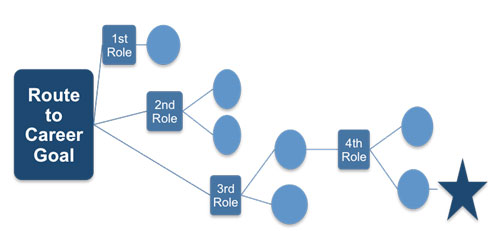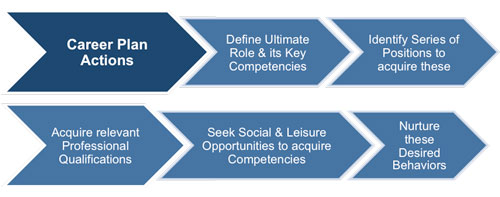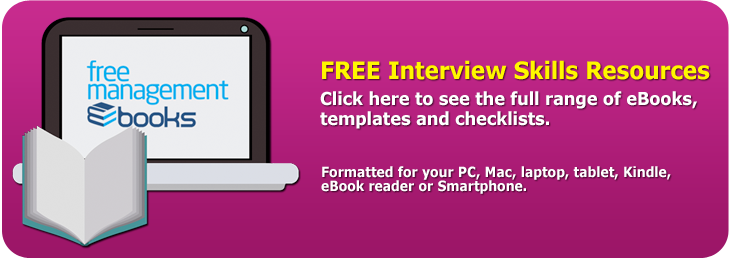Professional Development and Assessment
Each new role you apply for should fit into a long-term career plan or offer the opportunity to acquire a specific and desirable skill. To ensure that every role you perform aids your development by enabling you to acquire the right competencies you will need a long-term career plan.
Knowing your ultimate goal lets you set short-term goals or milestones so that you can seek the best opportunities to develop your competencies. These milestones should allow for flexibility, enabling you to respond to new economic and environmental factors.
Your continuous professional development (CPD) should then focus on attaining this long-term goal by exploiting short-term opportunities that bring it closer to being realized.
 |
For example, in the simplistic diagram above it took someone four role changes to attain their career goal. Each circle leading off a role box represents the additional competencies that enabled them to be promoted or move organizations to attain the goal.
Career Plan Map
In order to define a career goal you need to understand the competencies that are required to perform that role. You can then think about the type of roles and activities that will help you attain these competencies; these can then be used to develop a career map.
 |
The level of detail within your map will reflect your knowledge of the market and the role you wish to pursue, and it will help guide you when considering opportunities that arise. The map will also help you maximize your CPD because it will help you to focus on what is essential rather than just desirable.
A useful feature of a career map is that by listing the competencies your ultimate role requires, you can identify key role changes. For example, a key change occurs when an individual moves from a supervisory to a management role. Supervisory behaviors focus on producing deliverables, whereas management behaviors focus more on delegation, developing others, and budgetary management.
Many people fail to move up from supervisory positions to management because they are unable to provide objective and reliable evidence that they have the right level of management competencies. This problem has become worse in the past 20 years as few organizations now have a defined career path for existing staff. This is due to cost considerations; it is obviously cheaper to bring in outsiders who already have the relevant competencies rather than to develop them internally.
The effect of this is that many people find themselves having to be more self-reliant when it comes to professional development than would have been the case in the past. This can mean taking professional qualifications in their own time and financing themselves to do so.
Another way to develop the required management behaviors is to seek out social or leisure opportunities that help you to acquire them. Offering your free time to charities, sports clubs, and schools can all be excellent ways to develop these types of skill. For example, acting as a treasurer for a sports club can provide you with the opportunity to develop budgeting and basic financial reporting competencies.
You may also be interested in:
Management Assessment | Assessment Exercises and Format | What Assessors are Looking For | Initial Preparation for a Management Assessment | Detailed Preparation for a Management Assessment | Professional Development and Assessment.

